Abstract
Mouse lymphocytes incubated with micromolar concentrations of adenosine or 3-deazaadenosine, in medium supplemented with L-homocysteine, rapidly accumulated supramillimolar concentrations of S-adenosylhomocysteine (AdoHcy) or S-3-deazaadenosylhomocysteine (c3AdoHcy), respectively. Lymphocytes thus preloaded with high levels of AdoHcy or c3AdoHcy exhibited markedly enhanced (5- to 40-fold) cyclic AMP responses to prostaglandin E1, adenosine, 2-chloroadenosine, isoproterenol, and cholera toxin. This enhancement of cyclic AMP response by intracellular AdoHcy or c3AdoHcy was attributable both to amplification of the activity of adenylate cyclase [ATP pyrophosphate-lyase (cyclizing), EC 4.6.1.1] and to inhibition of cyclic AMP phosphodiesterase (3',5'-cyclic-nucleotide 5'-nucleotidohydrolase, EC 3.1.4.17). Basal and prostaglandin E1- and isoproterenol-stimulated activities of adenylate cyclase, assayed in lymphocyte homogenates, were increased 1.3- to 2.0-fold after treatment of the cells with homocysteine plus either adenosine or 3-deazaadenosine. AdoHcy and c3AdoHcy were found to be competitive inhibitors (with Ki values of 1.7 and 4.8 mM, respectively) of the high-affinity cyclic AMP phosphodiesterase present in lymphocyte homogenates. It is evident, therefore, that increased cellular levels of AdoHcy or c3AdoHcy can affect cellular physiology via perturbation of cyclic AMP metabolism as well as via inhibition of S-adenosylmethionine-dependent methylation reactions.
Full text
PDF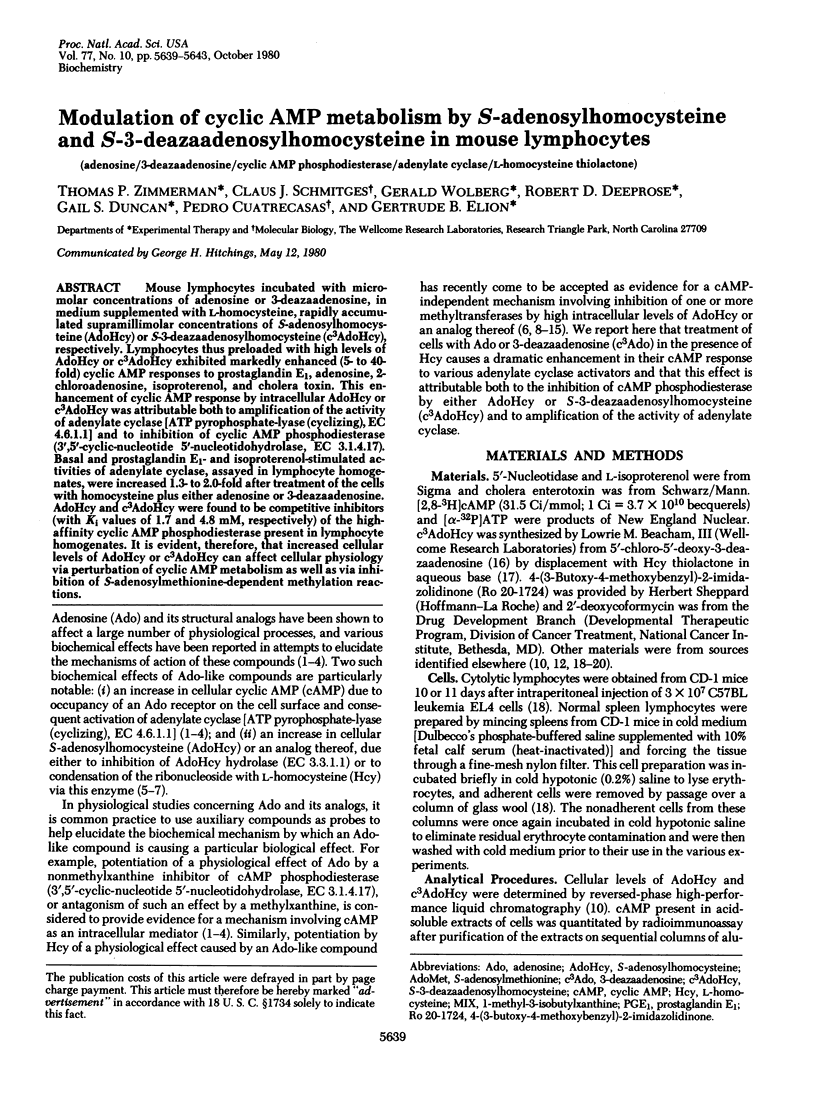
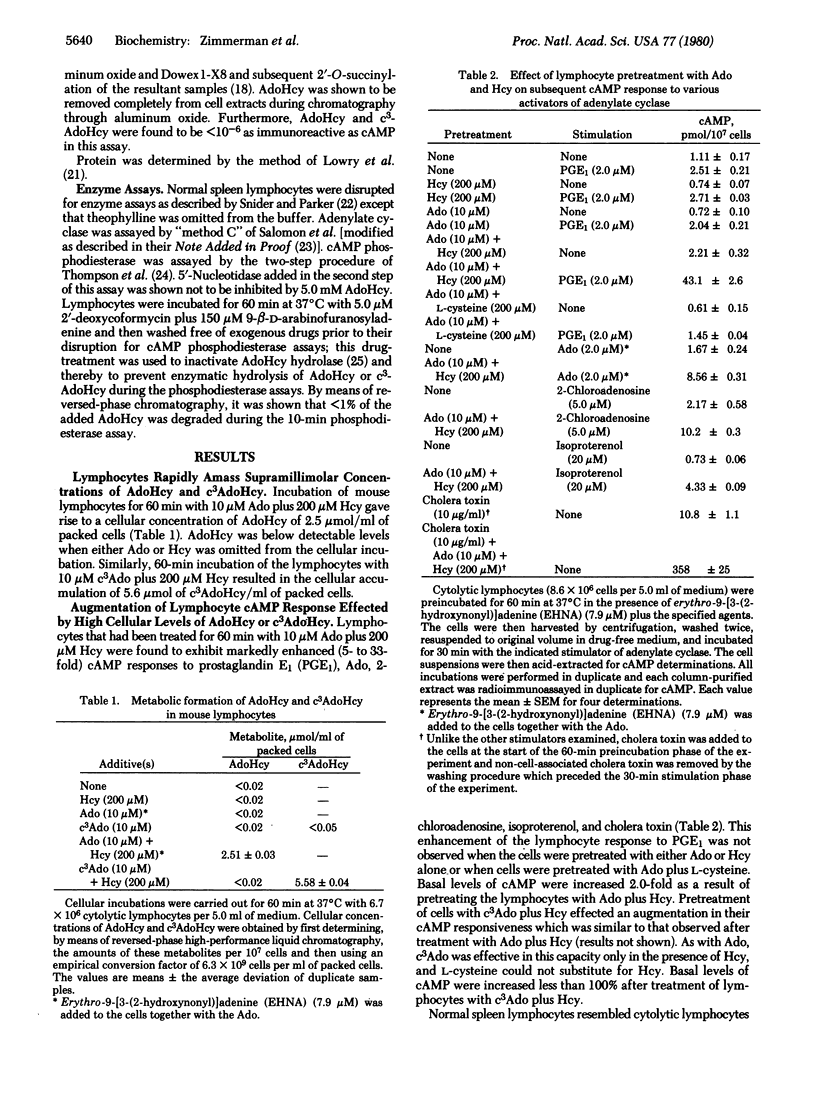
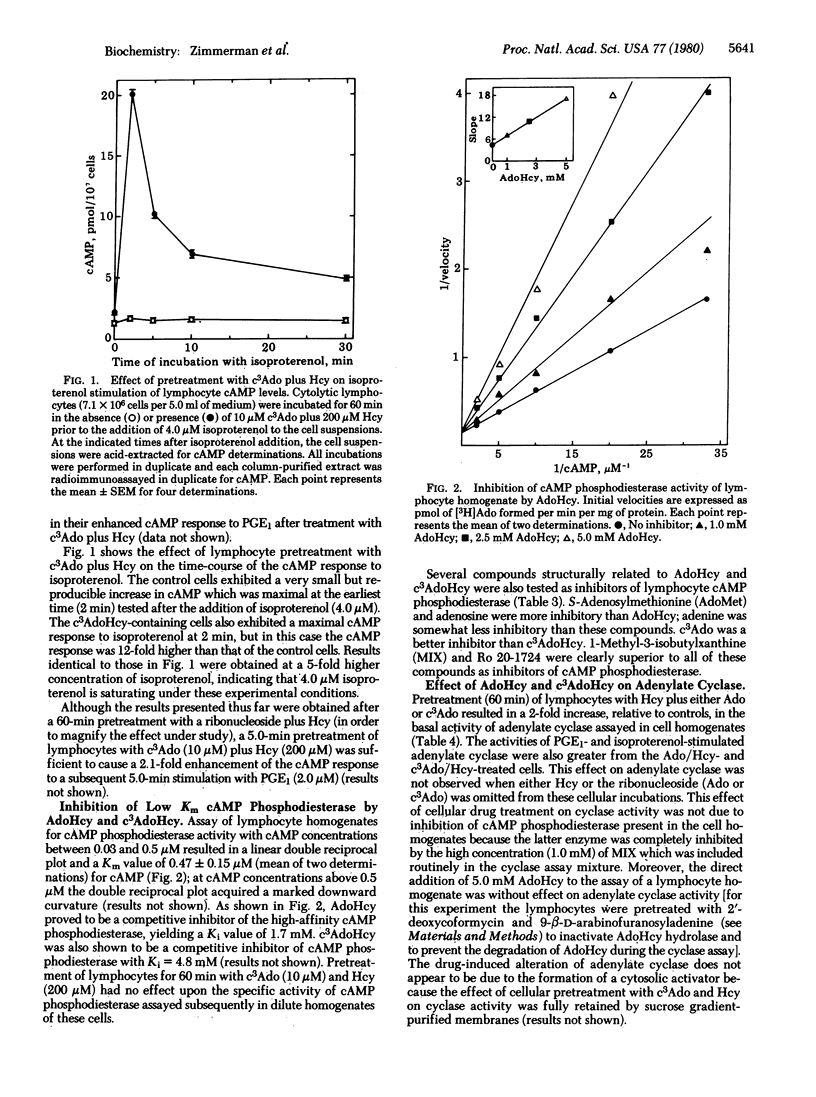
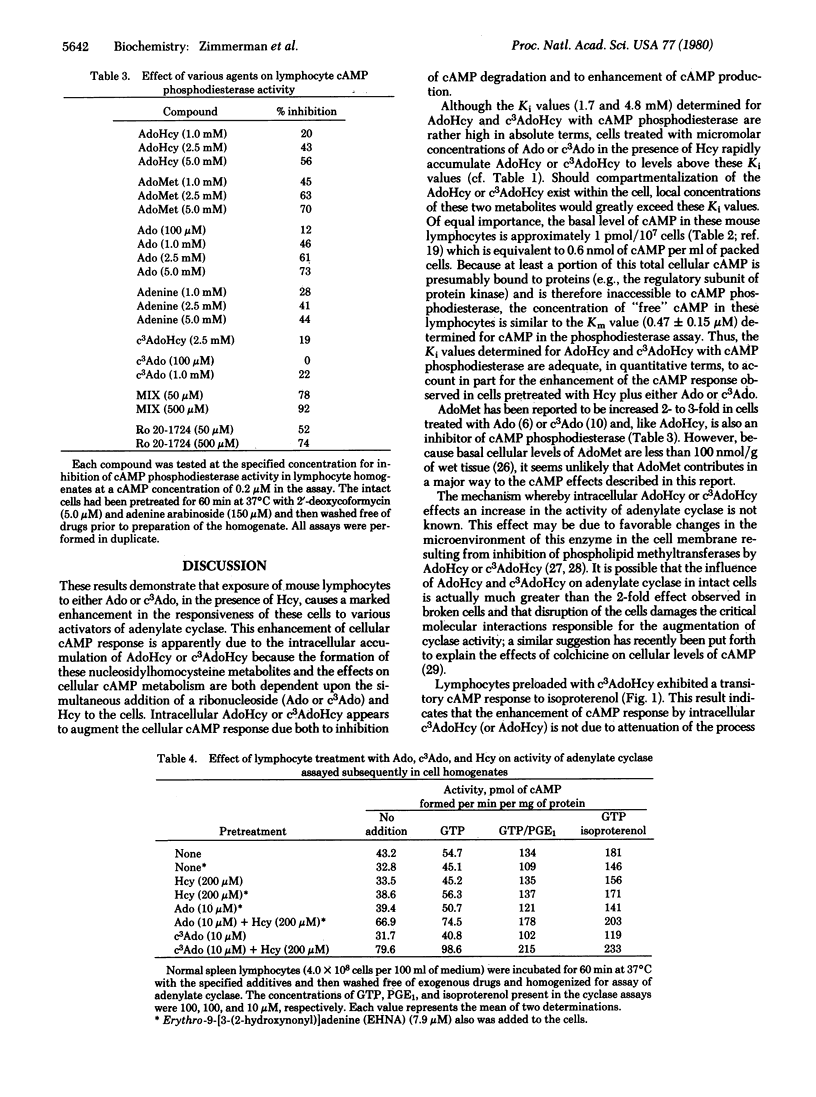
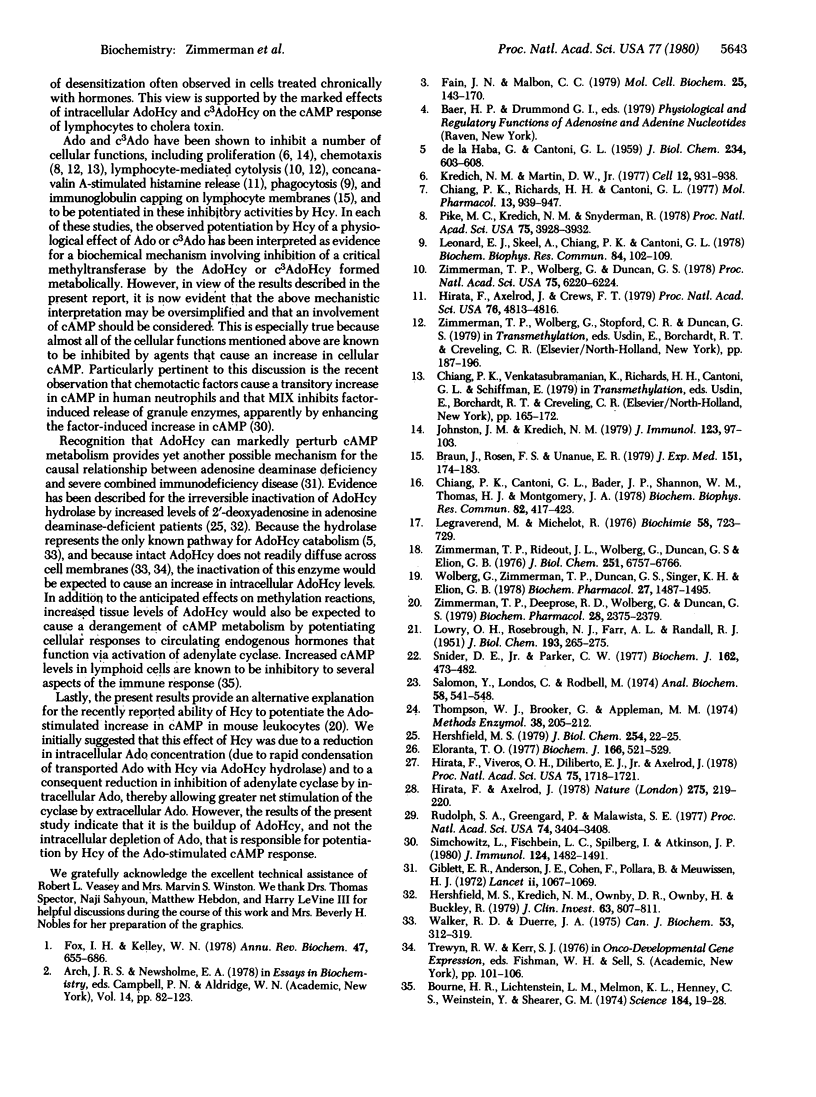
Selected References
These references are in PubMed. This may not be the complete list of references from this article.
- Bourne H. R., Lichtenstein L. M., Melmon K. L., Henney C. S., Weinstein Y., Shearer G. M. Modulation of inflammation and immunity by cyclic AMP. Science. 1974 Apr 5;184(4132):19–28. doi: 10.1126/science.184.4132.19. [DOI] [PubMed] [Google Scholar]
- Braun J., Rosen F. S., Unanue E. R. Capping and adenosine metabolism. Genetic and pharmacologic studies. J Exp Med. 1980 Jan 1;151(1):174–183. doi: 10.1084/jem.151.1.174. [DOI] [PMC free article] [PubMed] [Google Scholar]
- Chiang P. K., Cantoni G. L., Bader J. P., Shannon W. M., Thomas H. J., Montgomery J. A. Adenosylhomocysteine hydrolase inhibitors: synthesis of 5'-deoxy-5'-(isobutylthio)-3-deazaadenosine and its effect on Rous sarcoma virus and Gross murine leukemia virus. Biochem Biophys Res Commun. 1978 May 30;82(2):417–423. doi: 10.1016/0006-291x(78)90892-6. [DOI] [PubMed] [Google Scholar]
- Chiang P. K., Richards H. H., Cantoni G. L. S-Adenosyl-L-homocysteine hydrolase: analogues of S-adenosyl-L-homocysteine as potential inhibitors. Mol Pharmacol. 1977 Sep;13(5):939–947. [PubMed] [Google Scholar]
- DE LA HABA G., CANTONI G. L. The enzymatic synthesis of S-adenosyl-L-homocysteine from adenosine and homocysteine. J Biol Chem. 1959 Mar;234(3):603–608. [PubMed] [Google Scholar]
- Eloranta T. O. Tissue distribution of S-adenosylmethionine and S-adenosylhomocysteine in the rat. Effect of age, sex and methionine administration on the metabolism of S-adenosylmethionine, S-adenosylhomocysteine and polyamines. Biochem J. 1977 Sep 15;166(3):521–529. doi: 10.1042/bj1660521. [DOI] [PMC free article] [PubMed] [Google Scholar]
- Fain J. N., Malbon C. C. Regulation of adenylate cyclase by adenosine. Mol Cell Biochem. 1979 Jun 15;25(3):143–169. doi: 10.1007/BF00235364. [DOI] [PubMed] [Google Scholar]
- Fox I. H., Kelley W. N. The role of adenosine and 2'-deoxyadenosine in mammalian cells. Annu Rev Biochem. 1978;47:655–686. doi: 10.1146/annurev.bi.47.070178.003255. [DOI] [PubMed] [Google Scholar]
- Giblett E. R., Anderson J. E., Cohen F., Pollara B., Meuwissen H. J. Adenosine-deaminase deficiency in two patients with severely impaired cellular immunity. Lancet. 1972 Nov 18;2(7786):1067–1069. doi: 10.1016/s0140-6736(72)92345-8. [DOI] [PubMed] [Google Scholar]
- Hershfield M. S. Apparent suicide inactivation of human lymphoblast S-adenosylhomocysteine hydrolase by 2'-deoxyadenosine and adenine arabinoside. A basis for direct toxic effects of analogs of adenosine. J Biol Chem. 1979 Jan 10;254(1):22–25. [PubMed] [Google Scholar]
- Hershfield M. S., Kredich N. M., Ownby D. R., Ownby H., Buckley R. In vivo inactivation of erythrocyte S-adenosylhomocysteine hydrolase by 2'-deoxyadenosine in adenosine deaminase-deficient patients. J Clin Invest. 1979 Apr;63(4):807–811. doi: 10.1172/JCI109367. [DOI] [PMC free article] [PubMed] [Google Scholar]
- Hirata F., Axelrod J., Crews F. T. Concanavalin A stimulates phospholipid methylation and phosphatidylserine decarboxylation in rat mast cells. Proc Natl Acad Sci U S A. 1979 Oct;76(10):4813–4816. doi: 10.1073/pnas.76.10.4813. [DOI] [PMC free article] [PubMed] [Google Scholar]
- Hirata F., Axelrod J. Enzymatic methylation of phosphatidylethanolamine increases erythrocyte membrane fluidity. Nature. 1978 Sep 21;275(5677):219–220. doi: 10.1038/275219a0. [DOI] [PubMed] [Google Scholar]
- Hirata F., Viveros O. H., Diliberto E. J., Jr, Axelrod J. Identification and properties of two methyltransferases in conversion of phosphatidylethanolamine to phosphatidylcholine. Proc Natl Acad Sci U S A. 1978 Apr;75(4):1718–1721. doi: 10.1073/pnas.75.4.1718. [DOI] [PMC free article] [PubMed] [Google Scholar]
- Johnston J. M., Kredich N. M. Inhibition of methylation by adenosine in adenosine deaminase-inhibited, phytohemagglutinin-stimulated human lymphocytes. J Immunol. 1979 Jul;123(1):97–103. [PubMed] [Google Scholar]
- Kredich N. M., Martin D. V., Jr Role of S-adenosylhomocysteine in adenosinemediated toxicity in cultured mouse T lymphoma cells. Cell. 1977 Dec;12(4):931–938. doi: 10.1016/0092-8674(77)90157-x. [DOI] [PubMed] [Google Scholar]
- LOWRY O. H., ROSEBROUGH N. J., FARR A. L., RANDALL R. J. Protein measurement with the Folin phenol reagent. J Biol Chem. 1951 Nov;193(1):265–275. [PubMed] [Google Scholar]
- Legraverend M., Michelot R. Nouvelles synthèse d'analogues de la S-adénosyl homocystéine et de la S-adénosyl-méthionine. Biochimie. 1976;58(6):723–729. doi: 10.1016/s0300-9084(76)80397-5. [DOI] [PubMed] [Google Scholar]
- Leonard E. J., Skeel A., Chiang P. K., Cantoni G. L. The action of the adenosylhomocysteine hydrolase inhibitor, 3-deazaadenosine, on phagocytic function of mouse macrophages and human monocytes. Biochem Biophys Res Commun. 1978 Sep 14;84(1):102–109. doi: 10.1016/0006-291x(78)90269-3. [DOI] [PubMed] [Google Scholar]
- Pike M. C., Kredich N. M., Snyderman R. Requirement of S-adenosyl-L-methionine-mediated methylation for human monocyte chemotaxis. Proc Natl Acad Sci U S A. 1978 Aug;75(8):3928–3932. doi: 10.1073/pnas.75.8.3928. [DOI] [PMC free article] [PubMed] [Google Scholar]
- Rudolph S. A., Greengard P., Malawista S. E. Effects of colchicine on cyclic AMP levels in human leukocytes. Proc Natl Acad Sci U S A. 1977 Aug;74(8):3404–3408. doi: 10.1073/pnas.74.8.3404. [DOI] [PMC free article] [PubMed] [Google Scholar]
- Salomon Y., Londos C., Rodbell M. A highly sensitive adenylate cyclase assay. Anal Biochem. 1974 Apr;58(2):541–548. doi: 10.1016/0003-2697(74)90222-x. [DOI] [PubMed] [Google Scholar]
- Simchowitz L., Fischbein L. C., Spilberg I., Atkinson J. P. Induction of a transient elevation in intracellular levels of adenosine-3',5'-cyclic monophosphate by chemotactic factors: an early event in human neutrophil activation. J Immunol. 1980 Mar;124(3):1482–1491. [PubMed] [Google Scholar]
- Snider D. E., Jr, Parker C. W. Adenylate cyclase activity in lymphocyte subcellular fractions. Characterization of non-nuclear adenylate cyclase. Biochem J. 1977 Mar 15;162(3):473–482. doi: 10.1042/bj1620473a. [DOI] [PMC free article] [PubMed] [Google Scholar]
- Thompson W. J., Brooker G., Appleman M. M. Assay of cyclic nucleotide phosphodiesterases with radioactive substrates. Methods Enzymol. 1974;38:205–212. doi: 10.1016/0076-6879(74)38033-0. [DOI] [PubMed] [Google Scholar]
- Walker R. D., Duerre J. A. S-adenosylhomocysteine metabolism in various species. Can J Biochem. 1975 Mar;53(3):312–319. doi: 10.1139/o75-044. [DOI] [PubMed] [Google Scholar]
- Wolberg G., Zimmerman T. P., Duncan G. S., Singer K. H., Elion G. B. Inhibition of lymphocyte-mediated cytolysis by adenosine analogs. Biochemical studies concerning mechanism of action. Biochem Pharmacol. 1978 May 15;27(10):1487–1495. doi: 10.1016/0006-2952(78)90105-3. [DOI] [PubMed] [Google Scholar]
- Zimmerman T. P., Deeprose R. D., Wolberg G., Duncan G. S. Potentiation by homocysteine of adenosine-stimulated elevation of cellular adnosine 3',5'-monophosphate. Biochem Pharmacol. 1979 Aug 1;28(15):2375–2379. doi: 10.1016/0006-2952(79)90703-2. [DOI] [PubMed] [Google Scholar]
- Zimmerman T. P., Rideout J. L., Wolberg G., Duncan G. S., Elion G. B. 2-Fluoroadenosine 3':5'-monophosphate. A metabolite of 2-fluoroadenosine in mouse cytotoxic lymphocytes. J Biol Chem. 1976 Nov 10;251(21):6757–6766. [PubMed] [Google Scholar]
- Zimmerman T. P., Wolberg G., Duncan G. S. Inhibition of lymphocyte-mediated cytolysis by 3-deazaadenosine: evidence for a methylation reaction essential to cytolysis. Proc Natl Acad Sci U S A. 1978 Dec;75(12):6220–6224. doi: 10.1073/pnas.75.12.6220. [DOI] [PMC free article] [PubMed] [Google Scholar]


